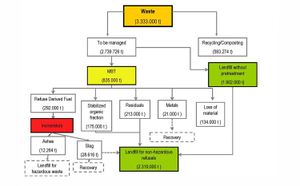Modelling contaminant releases: waste
- The text on this page is taken from an equivalent page of the IEHIAS-project.
As part of the EU-funded INTARESE project, which contributed to the development of this Toolbox, a case study was carried out to assess health impacts of different waste management strategies in three study areas, in Italy, the UK and Slovenia.

The Italian study focused on the Lazio region of Italy, including Rome, and assessed health effects from air pollution associated with both waste incinerators and landfill sites, under three different policy scenarios - the current (business-as-usual) strategy, a more intensive waste management strategy and a green (waste minimisation) strategy. In order to model dispersion of air pollutants, detailed emission data were needed for the 4 municipal waste incinerators and 10 landfill sites operating in the Lazio region, both under current conditions and for the different policy scenarios.
Two key sets of information are needed to calculate emissions: on source activity (in this case the amounts of waste being passed to incinerators and landfill), and on the emissions per unit of waste under each system (emission factors).
Data on current source activity were obtained from the Lazio regional Waste Authority, which describes in detail the waste flows within the region (in Tonnes). Figure 1 summarises the flows.
Obtaining representative emission factors proved far more difficult. No detailed emission factors were available for the incinerators operating in the Lazio region, but data for similar incinerators were available for the neighbouring region of Emilia-Romagna, for two years - 1996 and 2003 (see Table 1). Emission factors for 2001 for the Lazio incinerators were therefore calculated by averaging the two years.
For landfill sites, no emission factors existed for any area of Italy, and instead the case study had to resort to using data from the UK (Table 1). This obviously generates some uncertainty in the analysis, for differences between the two countries may be expected in the composition of the wastes, the management regimes and the decomposition environment. In the absence of alternative sources of data, however, these data were considered the best available.
| Pollutant | Municipal waste incinerator | Landfill (flairing)3 | ||
| Emilia-Rornagna1 | Lazio region | UK | ||
| 1996 | 2003 | 20012 | 2001 | |
| PM | 28 | 22 | 25 | 6.1 |
| NOx | 1598 | 1290 | 1444 | 75 |
- 1. Measured values from eight plants in Emilia-Rornagna
- 2. Lazio region emission factorc for 2001 estimated as average of 1996 and 2003 data from Emilia-Rornagna
- 3. Enviros 2004
Emission rates for the incinerators and landfill sites were then estimated by apportioning the waste flows in Figure 1 between the sites, and these multiplied by the emission factors.
In order to estimate emissions under the future scenarios, these data had to be further modelled, to allow for changes in waste generation and treatment methods. Details are given in the case study report, which is downloadable below.
References
- Enviros 2004 Review of environmental and health effects of waste management: municipal solid waste and similar wastes. London: Department of Environment Transport and the Regions (DEFRA), UK.
See also
A description of how the emissions data were then used to model atmospheric dispersion is available on page Dispersion modelling: waste.